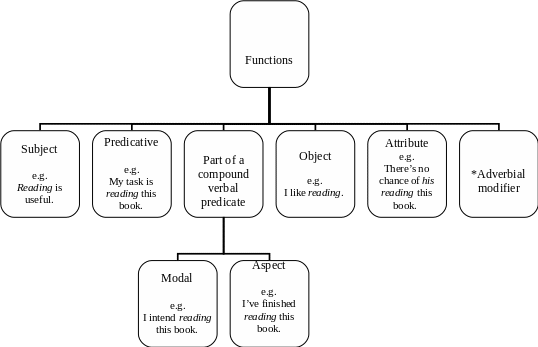
- •Содержание
- •Введение
- •Раздел I. Введение.
- •Theoretical grammar as a brunch of linguistics
- •Systemic conception of language
- •Discrimination of Language and Speech
- •Hierarchy of Language Levels
- •Language Units and Speech Units
- •Systemic Relations in Language
- •Morphology morphemic structure of the word
- •Traditional Classification of Morphemes
- •Allo-emic Classification of Morphemes
- •Types of Distribution
- •Categorial structure of the word
- •Grammatical means
- •Grammatical forms
- •Inflextional forms
- •Inner inflextional forms
- •Neutralization
- •Transposition
- •Grammatical classes of words
- •Parts of speech
- •Nominative parts of speech
- •Particles
- •Word classes
- •4 Major classes of words 15 Form-classes
- •Noun and its categories semantic features of the noun
- •Morphological features of the noun
- •Categories of the Noun
- •Category of Number
- •Indiscreteness is explicitly expressed
- •Types of Oppositional Reduction
- •Category of Case
- •Case Theories
- •Category of Gender
- •Category of Article Determination
- •Syntactic features of the noun
- •Verb and its categories classifications of verbs
- •Category of Finitude
- •Categories of the verb Categories of Person and Number
- •Category of Aspect
- •Evolution of Views
- •Category of Retrospect
- •Category of Voice
- •Category of Mood
- •The Infinitive
- •The Gerund
- •Double Nature of the Gerund
- •The Participle
- •Adjective semantic features of the adjective
- •Morphological features of the adjective
- •Adjectives that do not Form Degrees of Comparison
- •Syntactic features of the adjective
- •Order of Adjectives before a Noun
- •Stative symantic features of the stative
- •Morphological features of the stative
- •Syntactic features of the stative
- •The Adjective and the Stative
- •Adverb semantic features of the adverb
- •Morphological features of the adverb
- •Syntactic features of the adverb
- •Syntax word-group theory
- •Sentence: general
- •Classification of Sentences
- •Communicative Classification of Sentences
- •Simple sentence
- •Sentence parts
- •Principle sentence parts subject
- •Predicate
- •The simple predicate can be of two types: verbal and nominal. The simple verbal predicate can be expressed in two ways (Fig. 122).
- •Compound Verbal Modal Predicate
- •Compound Nominal Predicate
- •Secondary sentence parts object
- •Attribute
- •Apposition
- •Adverbial modifier
- •Independent elements of the sentence
- •Composite sentence
- •The means of combining clauses into a polypredicative sentence are divided into syndetic, I. E. Conjunctional, and asyndetic, I. E. Non-conjunctional (Fig. 144).
- •Compound sentence
- •There exist two different bases of classifying subordinate clauses: the first is functional, the second is categorical.
- •Glossary of linguistic terms
- •Refferences
- •Заключение
- •454080 Г. Челябинск, пр. Ленина, 69
- •454080 Г. Челябинск, пр. Ленина, 69
The Gerund
The gerund is a non-finite form of the verb with some noun features (Fig. 71). The gerund serves as the verbal name of a process.

Fig. 71
The general combinability of the gerund is dual (Table 9). Morphologically the verbal character of the gerund is manifested in the categories of voice and perfect. The verb-type combinability of the gerund is displayed in its combining with with nouns expressing the object of the action; second, with modifying adverbs; third, with certain semi-functional predicator verbs, but other than modal.
The nominal character of the gerund reveals itself syntactically, mainly in its syntactical function, partly in its combinability. Like a noun, it can function as subject, object, or predicative. When it is an attribute or an adverbial modifier, a gerund, like a noun is preceded by a preposition. The fact that the gerund can associate with a preposition is a sure sign of noun features. Like a noun, but unlike the other non-finites, it can combine with a possessive pronoun and a noun in the genitive case denoting the doer of the action expressed by the gerund.
Table 9
Double Nature of the Gerund
Nominal character |
Verbal character |
1. It can be used as a subject of a sentence e.g. Seeing is believing. |
1. It can take a direct object (transitive verbs) e.g. He likes doing it. |
2. It can be used as an object e.g. He likes doing it. |
2. It can be modified by an adverb e.g. They burst out laughing loudly. |
3. It can be used as a predicative e.g. Seeing is believing. |
3. It has tense distinctions and voice distinctions (transitive verbs) |
4. It can be modified by a noun in the genitive case or a possessive pronoun e.g. I’m not surprised at his coming so late. |
|
e.g. I’m not surprised at his coming so late. |
The gerund is a categorially changeable form. It distinguishes two grammatical categories, namely, the aspective category of retrospective coordination (perfect in opposition), and the category of voice (passive in opposition) (Fig. 72).

Fig. 72
Thus, the categorial paradigm of the gerund of the objective verb includes four forms (Table 10).
Table 10
Forms of the Gerund
|
Active |
Passive |
Indefinite |
doing |
being done |
Perfect |
having done |
having been done |
Fig. 73

Fig. 74

The gerund performs the functions of all types of notional sentence-parts, i. e. the subject, the object, the predicative, the attribute, the adverbial modifier (Fig. 73, Fig. 74). In all syntactical functions it has peculiarities of its own. It may function alone, without modifiers, or as the headword of a gerundial phrase, or as part of a gerundial predicative construction.
A gerundial construction contains some nominal element denoting the doer of the action expressed by the gerund and the gerund itself with or without some other words depending on it. The nominal element can be a noun in the genitive case or a possessive pronoun (if it denotes a living being), or a noun in the common case (if it does not denote a living being). There is a growing tendency, especially in informal speech, to use the pronoun in the objective case and a noun in the common case to denote the doer of the action expressed by the gerund with reference to living beings too. The gerundial constructions are usually translated by clauses.
